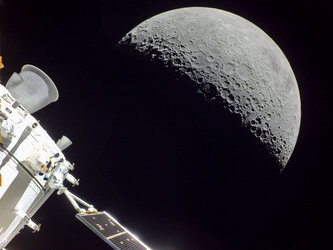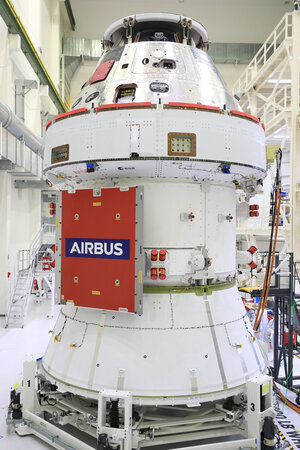Accept all cookies Accept only essential cookies See our Cookie Notice

About ESA
The European Space Agency (ESA) is Europe’s gateway to space. Its mission is to shape the development of Europe’s space capability and ensure that investment in space continues to deliver benefits to the citizens of Europe and the world.
Highlights
ESA - United space in Europe
This is ESA ESA facts Member States & Cooperating States Funding Director General Top management For Member State Delegations European vision European Space Policy ESA & EU Space Councils Responsibility & Sustainability Annual Report Calendar of meetings Corporate newsEstablishments & sites
ESA Headquarters ESA ESTEC ESA ESOC ESA ESRIN ESA EAC ESA ESAC Europe's Spaceport ESA ESEC ESA ECSAT Brussels Office Washington OfficeWorking with ESA
Business with ESA ESA Commercialisation Gateway Law at ESA Careers Cyber resilience at ESA IT at ESA Newsroom Partnerships Merchandising Licence Education Open Space Innovation Platform Integrity and Reporting Administrative Tribunal Health and SafetyMore about ESA
History ESA Historical Archives Exhibitions Publications Art & Culture ESA Merchandise Kids Diversity ESA Brand CentreLatest
Space in Member States
Find out more about space activities in our 23 Member States, and understand how ESA works together with their national agencies, institutions and organisations.
Science & Exploration
Exploring our Solar System and unlocking the secrets of the Universe
Go to topicAstronauts
Missions
Juice Euclid Webb Solar Orbiter BepiColombo Gaia ExoMars Cheops Exoplanet missions More missionsActivities
International Space Station Orion service module Gateway Concordia Caves & Pangaea BenefitsLatest
Space Safety
Protecting life and infrastructure on Earth and in orbit
Go to topicAsteroids
Asteroids and Planetary Defence Asteroid danger explained Flyeye telescope: asteroid detection Hera mission: asteroid deflection Near-Earth Object Coordination CentreSpace junk
About space debris Space debris by the numbers Space Environment Report In space refuelling, refurbishing and removingSafety from space
Clean Space ecodesign Zero Debris Technologies Space for Earth Supporting Sustainable DevelopmentLatest
Applications
Using space to benefit citizens and meet future challenges on Earth
Go to topicObserving the Earth
Observing the Earth Future EO Copernicus Meteorology Space for our climate Satellite missionsCommercialisation
ESA Commercialisation Gateway Open Space Innovation Platform Business Incubation ESA Space SolutionsLatest
Enabling & Support
Making space accessible and developing the technologies for the future
Go to topicBuilding missions
Space Engineering and Technology Test centre Laboratories Concurrent Design Facility Preparing for the future Shaping the Future Discovery and Preparation Advanced Concepts TeamSpace transportation
Space Transportation Ariane Vega Space Rider Future space transportation Boost! Europe's Spaceport Launches from Europe's Spaceport from 2012Latest

Lunar encore
Thank you for liking
You have already liked this page, you can only like it once!
Happy international Moon day! Today marks the annual celebration of the Apollo 11 lunar landing on 20 July, in 1969. More than fifty years later, during the Artemis I mission on 28 November 2022, this image was captured by a camera placed on the tip of one of the European Service Module’s four solar array wings, part of the Orion spacecraft.
The frame shows the Orion spacecraft on the left with one solar wing extending from the European Service Module to the right, dividing Earth (above) and the Moon. The cones on the European Service Module are the thrusters for the engines the spacecraft has for propulsion. The smaller cones on the side, in groups of four are part of the reaction control system used to orient the spacecraft, and the larger ones facing the camera grouped by two are the auxiliary thrusters.
Artemis I is the first in a series of missions to propel humankind forward to the Moon and beyond. The Artemis programme aims to establish permanent stations and outposts in orbit around our natural satellite. During the Artemis I test flight, the Orion spacecraft flew without astronauts. NASA provided the rocket and the crew capsule and ESA the European Service Module – Orion's 'powerhouse’.
The test flight allowed mission control at NASA’s Johnson Space Center to get a feel for the spacecraft and push it to the limits of its capabilities. To everyone's delight Orion exceeded all expectations. For the European experts who worked on the European Service Module, the mission was even more rewarding due to the live view of the commands provided by the cameras on board.
The primary purpose of the cameras was self-observation: to monitor the spacecraft on its two-week mission around the Moon. “As engineers we are lucky to have the livestream and high-quality photos, as they are rare, most satellites don’t take selfies,” says Thales Alenia Space’s Lorenzo Andrioli, “To see those images of Orion flying by the Moon and to think you have touched those components is a very special feeling.”
Orion was equipped with 16 strategically placed cameras across its structure, with one at the end of each of the four solar array wings. The wing cameras were especially versatile. The solar arrays were designed to swivel, pivot and rotate to capture as much sunlight as possible. During the test flight, they could also be repositioned to capture better views of the Moon. On occasion, the entire spacecraft was rotated to get extraordinary shots.
The European Service Module played a crucial role in enabling these photos. It consumed less fuel while also generating more electricity than required for the mission. The surplus of energy allowed for the repositioning of the spacecraft and solar wings.
Each operation in space requires close coordination between the spacecraft systems: electrical power, propulsion, thermal and data handling. Changing one parameter has immediate effects on the others, for example moving the solar panels would change the amount of electricity generated, and adjusting the spacecraft may necessitate the thermal team's preparation of heaters to maintain optimal operating temperatures.
With this resounding success, all is set for Artemis II which will see four astronauts orbit the Moon and return to Earth. NASA’s commander Reid Wiseman, pilot Victor Glover and mission specialist Christina Koch, together with Canadian Space Agency astronaut Jeremy Hansen will embark on this exciting mission in 2024.
-
CREDIT
NASA -
LICENCE
ESA Standard Licence

Orion with wings

Installing solar wings on Orion

Installing solar wings on Orion

European Service Module flies by the Moon















 Germany
Germany
 Austria
Austria
 Belgium
Belgium
 Denmark
Denmark
 Spain
Spain
 Estonia
Estonia
 Finland
Finland
 France
France
 Greece
Greece
 Hungary
Hungary
 Ireland
Ireland
 Italy
Italy
 Luxembourg
Luxembourg
 Norway
Norway
 The Netherlands
The Netherlands
 Poland
Poland
 Portugal
Portugal
 Czechia
Czechia
 Romania
Romania
 United Kingdom
United Kingdom
 Slovenia
Slovenia
 Sweden
Sweden
 Switzerland
Switzerland
























